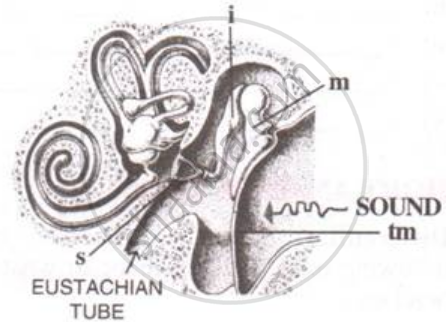Advertisements
Advertisements
Question
State whether the following statements are true (T) or false (F). If false, correct them by changing any one single word in each.
Semi-circular canals are concerned with static (positional) balance.
Options
True
False
Solution
This statement is False.
Correct statement:
Semi-circular canals are concerned with dynamic (rotational) balance.
APPEARS IN
RELATED QUESTIONS
Which part of our body helps us in maintaining the body balance?
Deafness is causal due to the rupturing of the Pinna.
Eye : Optic nerve : : Ear : ___________
State the exact location of the Ciliary body
Given in the box below are a set of 14 biological terms. Of these, 12 can be paired into 6 matching pairs. Out of the six pairs, one has been done for you as an example.
Example : endosmosis - Turgid cell.
Identify the remaining five matching pairs :
| Cushing’s syndrome, Turgid cell, Iris, Free of rod and cone cells, Colour of eyes, Hypoglycemia, Active transport, Acrosome, Addison’s disease, Blind spot, Hyperglycemia, Spermatozoa, Endosmosis, Clotting of blood. |
(i) Draw a well labelled diagram of the membranous labyrinth found in the inner ear.
(ii) Based on the diagram drawn above in (i) give a suitable term for each of the following descriptions :
1. The sensory cells that helps in hearing.
2. The part that is responsible for static balance of the body.
3. The membrane covered opening that connects the middle ear to the inner ear.
4. The fluid present in the middle chamber of cochlea.
5. The structure that maintains dynamic equilibrium of the body.
Give technical terms for The nerve which transmits impulses from the ear to the brain
Which part of our ear is shaped like a snail shell?
Where is the Cochlea located? Briefly mention its function.
With reference to the human ear, answer the question that follow:
Name the nerve, which transmits messages from the ear to the brain.
The figure below is the sectional view of a part of the skull showing s sense organ:

Name the sense organ.
There are three small bones in the muddle ear – anvil, hammer and stirrup :
(a) Which of these bones is in touch with ear-drum ?
(b) Which of these bones is in touch with oval window ?
Name the nerve which carries electrical impulses from the cochlea of ear to the brain.
What is the name of passage in outer ear which carries sound waves to the ear-drum ?
Given below is a diagram of a part of the human ear. Study the same and answer the question that follow:

State the functions of the parts labeled 'A' and 'B'.
Name the following:
The ear ossicle in contact with the oval window of the inner ear.
State the Function:
Endolymph
Vibrating particles travel all the way from the vibrating objects to the ear.
The median canal of cochlea is filled with ______.
